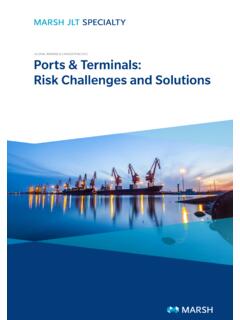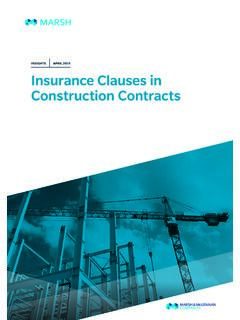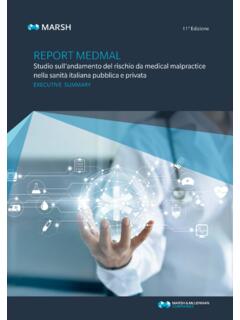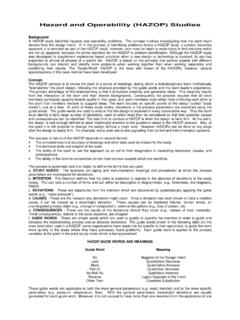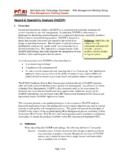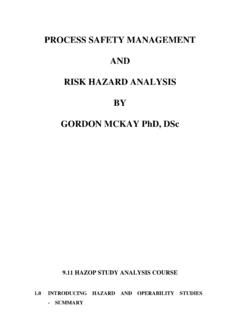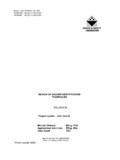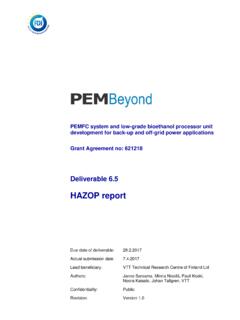Transcription of PROCESS HAZARD ANALYSIS (PHA) - Marsh
1 Energy PracticeRISK ENGINEERING POSITION PAPER 01 PROCESS HAZARD ANALYSIS (PHA) Marsh 3 RISK ENGINEERING POSITION PAPER1. Background 52. Objective 63. Scope 64. Specific Requirements 65. Stewardship of the PHA PROCESS 116. References 127.
2 Appendices 13 Appendix A: Industry Losses 14 Appendix B: Common PHA Techniques 15 Appendix C: Self-Assessment Checklist 19 CONTENTS4 PROCESS HAZARD ANALYSIS (PHA)RISK ENGINEERING POSITION PAPERM arsh 51. BACKGROUNDM ajor accidents on energy sites have the potential to result in hundreds of millions of dollars of physical damage, present a danger to employees and the local population, and can lead to significant business , there are steps that can be taken to address major accident HAZARD (MAH) threats and minimize the risk of a serious incident as part of a comprehensive PROCESS safety management (PSM) program.
3 A fundamental element of PSM, alongside others, such as mechanical integrity or management of change (MOC), is PROCESS HAZARD ANALYSIS , a key tool for understanding MAHs. PHA encompasses several techniques to evaluate and control hazards and risk levels respective to PROCESS operations to assess the suitability and effectiveness of existing safety barriers, and to help determine whether additional barriers or risk mitigation measures are needed. Therefore, the ineffective application or absence of PHA can significantly increase overall risk levels, and as outlined in Appendix A of this paper, the lack of a rigorous PHA program has been identified as a key contributing factor in several major recent loss events within the energy of the PHA techniques discussed in this paper are considered to be well-established within the industry, and have been standardized with templates developed for their execution in many organizations.
4 Each technique will have its own level of suitability and applicability, depending on a site s PROCESS maturity and complexity, as well as its overall PSM philosophy and objectives. Yet, no two PHAs are the same. The fact that a PHA is a team effort can lead to different outcomes depending on the PHA technique used and the skills and experience of the PHA Leader and team PROCESS HAZARD ANALYSIS (PHA)RISK ENGINEERING POSITION PAPER2. OBJECTIVEThe objective of this position paper is to define the key attributes that would be rated by Marsh as very good for a PHA PROCESS in the oil, gas, and petrochemical industry. These attributes reflect those in the Marsh energy risk ranking criteria.
5 They can be used to support and define risk improvement recommendations, and also to provide detailed advice to clients seeking to improve their management SCOPEThe scope of this position paper includes the development and application of a PHA PROCESS for carrying out periodic reviews of an operating asset s PROCESS safety studies, including those carried out as part of minor works or plant modifications. It is not intended to define the key attributes of a PHA or the risk assessment PROCESS as part of a larger engineering, procurement, and construction (EPC) should be noted that throughout this document, the term site is used to reference the part of the organization carrying out the PHA PROCESS .
6 Depending on the nature of the organization, this could be a single plant, multiple plants on the same site, or multiple sites. Although this document describes techniques that can be used by a site to carry out a PHA, it is not within its scope to provide detailed technique methodologies. 4. SPECIFIC REQUIREMENTST here should be a comprehensive written policy and procedure governing the PHA PROCESS for each site as part of the site s policy for the management of major hazards. Any corporate expectations for the PHA PROCESS should communicated, made readily available to member sites, and incorporated as appropriate into the site s policy and procedures. The policy and procedure for the PHA PROCESS should define the following elements: Objectives for carrying out a PHA.
7 The scope of the PHA. The PHA technique to be adopted. The key roles, responsibilities, and competence requirements for those involved in the PHA PROCESS . Managing the PHA schedule. The required documentation infrastructure to enable the PHA PROCESS to operate effectively. The preparation required for the PHA. The key steps in the PHA OF PHA STUDYA PHA study should evaluate the following: The PROCESS hazards. The identification of any previous incidents that had the potential for catastrophic consequences. Engineering and administrative controls applicable to the hazards and their interrelationships. Consequences of the failure of these controls. The broader considerations of facility siting.
8 Human factors that apply to the effective application of barriers or controls. A qualitative evaluation of the effect of control failure on the safety and health of site to the US Occupational Safety and Health Administration (OSHA), The key provision of PSM is PROCESS HAZARD ANALYSIS (PHA) a careful review of what could go wrong and what safeguards must be implemented to prevent releases of hazardous chemicals. In the EU, the scope of the PHA study will be influenced by the Seveso Directive, the main legislation addressing the control of onshore MAH threats involving dangerous substances, and by the Safety of Offshore Oil and Gas Operations Marsh 7 RISK ENGINEERING POSITION PAPERTHE PHA TECHNIQUE TO BE ADOPTED Within this paper, the following definitions are used, recognizing that different organizations may have different interpretations of the techniques discussed (refer to Appendix B for further detail on these and other commonly used PHA techniques).
9 TECHNIQUECOMMENTH azard identification (HAZID)Identification of significant hazards to ensure that there are appropriate measures in place to eliminate or reduce the risks to tolerable levels. Can be carried out once the basic PROCESS engineering design of a project or modification is and operability study ( hazop )A rigorous line-by-line review, this requires the piping and instrumentation diagrams (P&ID) to be finalized with a good understanding of the safety barriers that need to be adopted as part of the project, or those already installed when restudying an existing plant. If done too early in the development of the P&ID, the hazop can quickly degenerate into a design HAZARD review (PHR)A rigorous system-by-system review designed to operate at a higher level than a hazop , applying learning gained during site operation to previous versions of the PHA or hazop .
10 Safety integrity level (SIL) analysisAn assurance assessment that safety instrumented functions (SIF) provide the required safety performance and integrity. Typically carried out in parallel with a hazop or ANALYSIS (HAZAN)A quantitative ANALYSIS of a known HAZARD , including equipment reliability and HAZARD frequency data. It is most effectively done on an operating plant with known performance data, rather than using data that is either theoretical or implied. A tool also often used for SIL of protection ANALYSIS (LOPA)A semi-quantitative tool for analyzing and assessing risk. The timing would be similar to that for a hazop . Like HAZAN, it is a tool also often used for SIL analysisPrimarily a qualitative technique, this can be carried out once details of the safety barriers to be adopted/already employed are known, even though operating data, including that for human factors, may not yet be mode and effect ANALYSIS (FMEA)A systematic, typically qualitative, and methodical tabular technique for evaluating and documenting the causes and effects of known types of component failures.
